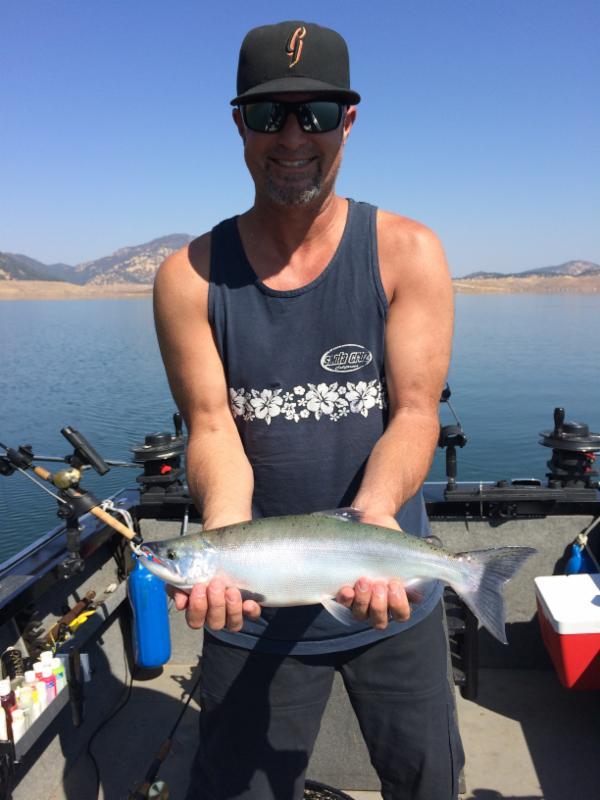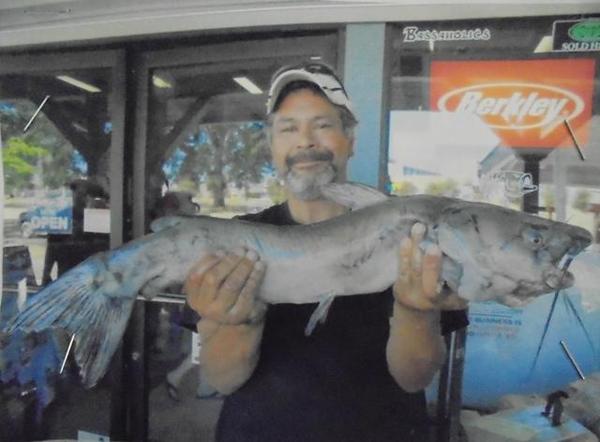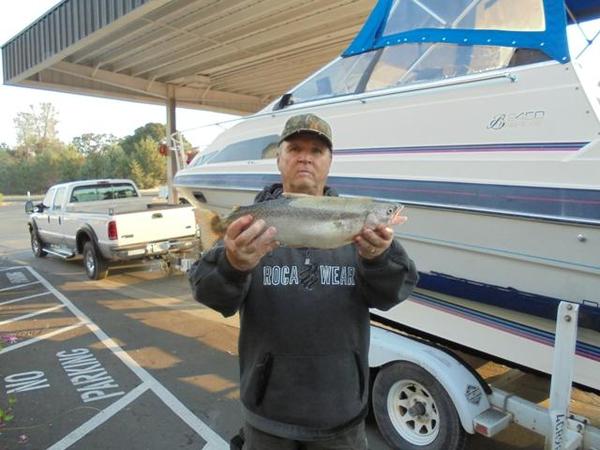Long Range Fish Report
From Sportfishing
From Sportfishing
Fish Report for 8-22-2016
Glory Hole Fishing Report
8-22-2016
Glory Hole Sports
Water Conditions: New Melones Lake is currently holding 550,505 acre-feet of water. The lake level dropped two feet this past week. It is currently at 868 ft. above sea level and 217 ft. from full. The water clarity is clear in most of the lake with a slight stain in some areas. The water temperature is warm, with the average being 78-82 degrees.
It looks like this will be the last week there is a two lane concrete ramp with a courtesy dock. There will be a courtesy dock on the dirt launch once the lake drops down to that elevation, which is approximately 865' in elevation.
Trout: Fair. Very few anglers are heading out in search of trout. The trout that are being caught are very healthy and weighing from 2 to 4-pounds. Most anglers are catching one here, one there with an occasional limit being put in the boat. The trout are holding in the deepest portions of the lake and seeking refuge in cooler water. Trolling anglers that want to specifically target trout should troll in 70' to 100' off water. Try trolling at faster speeds up to 3mph. The fast and erratic action will draw fish and they will react to the bait and strike. Presentations that have plenty of side-to-side wobble will produce vibration. This is very important when fishing in deep water with very little visibility. Rattle Traps and crankbaits that are typically used for bass will coax some of the large rainbow into biting. Night anglers have reported the bite slowing up a bit with fewer limits being caught. Look for areas with deep water nearby and drop your submersible light. The dam and the spillway are always productive areas to look for shad and trout. Bank anglers should try to catch small panfish or catfish from the shoreline at New Melones. To target trout from the shore, try heading to the high country lakes and rivers.
Glory Hole Sports Big Fish of the Week goes to Brian Basacker of Sonora. He caught a hefty 3-pound, 14-ounce trout near the spillway while fishing with nightcrawlers at night.
We do encourage catch and release for the brown trout as The Department of Fish and Game will no longer be planting them. Carefully measure, weigh and photograph trophy fish and send us pictures and information.
Kokanee: Slow. The kokanee season is winding down and we received reports of just a few being caught. The kokannee this year are large, pushing 20" and are holding in deep water ranging from 80-100'. The lake record is 2.8-pounds and was caught by Ray Koch of Escalon in 2007. The largest one that we heard of this year was 2.4-pounds. The lake record is out there and the next few weeks some lucky angler might catch it. It takes patience and the bites are few and far between, but the chance at a kokanee of this size does not come often. The fish will continue to hold in deep/cool water and will start to migrate upriver for their annual spawn. Try fishing in the main lake and up toward the 49-bridge. Use your GPS to ensure you are trolling over the main river channel. Large blades will work best at this time of the year. Swing and vibration are very important and will draw strikes from the largest kokanee. Also use lure combinations that have a large profile. An Apex/hoochie combo is tough to beat. Also, many anglers will modify spinners by adding more beads, larger blades and a wiggle disc to increase the action. Be sure to add scent and tip each hook with a piece of shoepeg corn.
Bass: Okay. The bass have pulled off the shoreline and are holding in deep water where it is much cooler and there is an abundance of bait. The large standing timber that is out in deep water will give the bass shelter and an area to ambush their prey. Schools of shad will be pushed around the lake. The key is to find them when they are in an area the bass are feeding. The bite will be fast and furious and then shut off completely. Make multiple stops and look for these windows of opportunity. The best times have been early mornings and late in the evenings. The bass will use these periods of low light to stalk the shad and other small fish. Try using lures that can be fished fast to cover water and eliminate unproductive areas. Once you locate some bait and bass it is a good idea to use a dropshot soft plastic and catch as many as you can. There are always fish that will hunker on the bottom and target crawdads. Use a football jig or a Carolina rig with a craw pattern. Be sure to keep contact with the bottom and deflect off structure and cover to draw strikes. PLEASE PRACTICE CATCH AND RELEASE. Take photos and carefully release the fish back into to the lake to maintain a healthy fish population for generations to come.
Ted Van Vuren caught a 7 1/2-pound largemouth bass. The fish crushed a topwater lure in the evening off the main river channel. We met his brother at the ramp and they gladly sent a picture of this beautiful fish.
Catfish: Good. Many anglers are catching some quality 4 to 10-pound catfish on each outing. The best time to target the cats is in the mornings, evenings and during the night. The catfish will move shallow to feed and it is best to target 5 to 15' of water. Look for areas with both rock and trees. The catfish will feed on shad and small sunfish. Try using frozen shad or sardines to coax these fish eaters into biting. Many anglers will stick to traditional baits such as nightcrawlers and chicken livers. Both baits will work and catch some giant cats each year.
Crappie: Fair. During the evening and night the crappie will feed on balls of shad. Look for areas with standing timber. Drop a submersible light and a live minnow to find success. If the shad show up and the crappie don't, try another area until you locate one that has actively feeding fish.
It looks like this will be the last week there is a two lane concrete ramp with a courtesy dock. There will be a courtesy dock on the dirt launch once the lake drops down to that elevation, which is approximately 865' in elevation.
Trout: Fair. Very few anglers are heading out in search of trout. The trout that are being caught are very healthy and weighing from 2 to 4-pounds. Most anglers are catching one here, one there with an occasional limit being put in the boat. The trout are holding in the deepest portions of the lake and seeking refuge in cooler water. Trolling anglers that want to specifically target trout should troll in 70' to 100' off water. Try trolling at faster speeds up to 3mph. The fast and erratic action will draw fish and they will react to the bait and strike. Presentations that have plenty of side-to-side wobble will produce vibration. This is very important when fishing in deep water with very little visibility. Rattle Traps and crankbaits that are typically used for bass will coax some of the large rainbow into biting. Night anglers have reported the bite slowing up a bit with fewer limits being caught. Look for areas with deep water nearby and drop your submersible light. The dam and the spillway are always productive areas to look for shad and trout. Bank anglers should try to catch small panfish or catfish from the shoreline at New Melones. To target trout from the shore, try heading to the high country lakes and rivers.
Glory Hole Sports Big Fish of the Week goes to Brian Basacker of Sonora. He caught a hefty 3-pound, 14-ounce trout near the spillway while fishing with nightcrawlers at night.
We do encourage catch and release for the brown trout as The Department of Fish and Game will no longer be planting them. Carefully measure, weigh and photograph trophy fish and send us pictures and information.
Kokanee: Slow. The kokanee season is winding down and we received reports of just a few being caught. The kokannee this year are large, pushing 20" and are holding in deep water ranging from 80-100'. The lake record is 2.8-pounds and was caught by Ray Koch of Escalon in 2007. The largest one that we heard of this year was 2.4-pounds. The lake record is out there and the next few weeks some lucky angler might catch it. It takes patience and the bites are few and far between, but the chance at a kokanee of this size does not come often. The fish will continue to hold in deep/cool water and will start to migrate upriver for their annual spawn. Try fishing in the main lake and up toward the 49-bridge. Use your GPS to ensure you are trolling over the main river channel. Large blades will work best at this time of the year. Swing and vibration are very important and will draw strikes from the largest kokanee. Also use lure combinations that have a large profile. An Apex/hoochie combo is tough to beat. Also, many anglers will modify spinners by adding more beads, larger blades and a wiggle disc to increase the action. Be sure to add scent and tip each hook with a piece of shoepeg corn.
Bass: Okay. The bass have pulled off the shoreline and are holding in deep water where it is much cooler and there is an abundance of bait. The large standing timber that is out in deep water will give the bass shelter and an area to ambush their prey. Schools of shad will be pushed around the lake. The key is to find them when they are in an area the bass are feeding. The bite will be fast and furious and then shut off completely. Make multiple stops and look for these windows of opportunity. The best times have been early mornings and late in the evenings. The bass will use these periods of low light to stalk the shad and other small fish. Try using lures that can be fished fast to cover water and eliminate unproductive areas. Once you locate some bait and bass it is a good idea to use a dropshot soft plastic and catch as many as you can. There are always fish that will hunker on the bottom and target crawdads. Use a football jig or a Carolina rig with a craw pattern. Be sure to keep contact with the bottom and deflect off structure and cover to draw strikes. PLEASE PRACTICE CATCH AND RELEASE. Take photos and carefully release the fish back into to the lake to maintain a healthy fish population for generations to come.
Ted Van Vuren caught a 7 1/2-pound largemouth bass. The fish crushed a topwater lure in the evening off the main river channel. We met his brother at the ramp and they gladly sent a picture of this beautiful fish.
Catfish: Good. Many anglers are catching some quality 4 to 10-pound catfish on each outing. The best time to target the cats is in the mornings, evenings and during the night. The catfish will move shallow to feed and it is best to target 5 to 15' of water. Look for areas with both rock and trees. The catfish will feed on shad and small sunfish. Try using frozen shad or sardines to coax these fish eaters into biting. Many anglers will stick to traditional baits such as nightcrawlers and chicken livers. Both baits will work and catch some giant cats each year.
Crappie: Fair. During the evening and night the crappie will feed on balls of shad. Look for areas with standing timber. Drop a submersible light and a live minnow to find success. If the shad show up and the crappie don't, try another area until you locate one that has actively feeding fish.
< Previous Report Next Report >
More Reports
Glory Hole Fishing Report
New Melones Reservoir
8-16-2016
Water Conditions: New Melones Lake is currently holding 558,722 acre-feet of water. The lake level dropped two...... Read More
Glory Hole Fishing Report
New Melones Reservoir
8-8-2016
Water Conditions: New Melones Lake is currently holding 571,517 acre-feet of water. The lake level dropped two feet this...... Read More

LongRangeSportfishing.net © 2025. All Rights Reserved.
Website Hosting and Design provided by TECK.net
Website Hosting and Design provided by TECK.net
